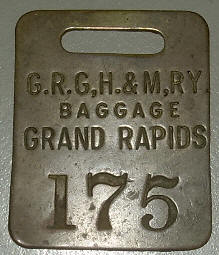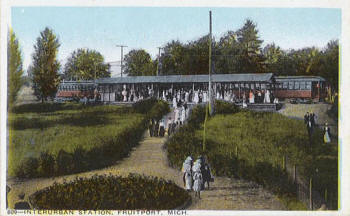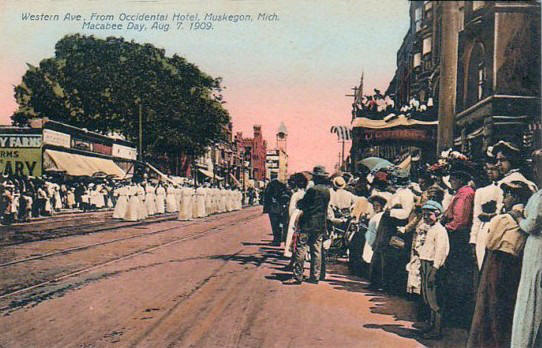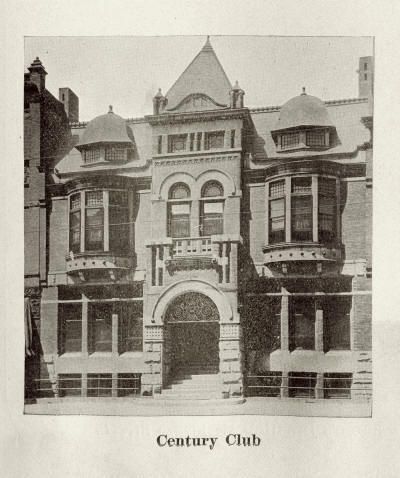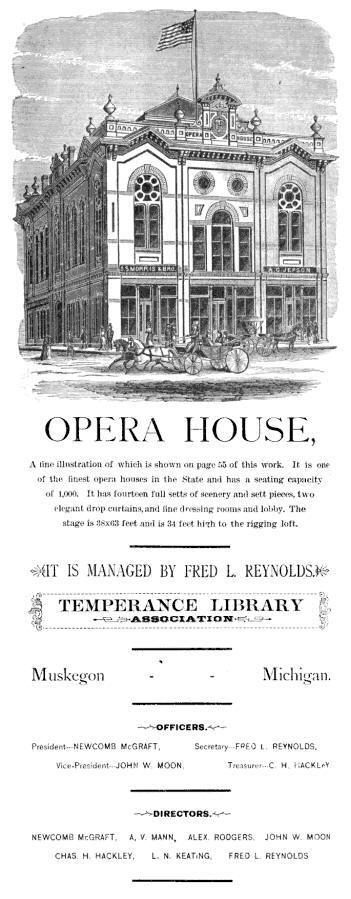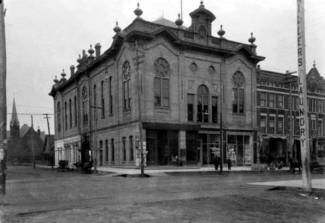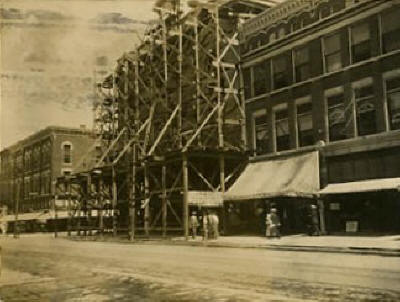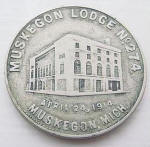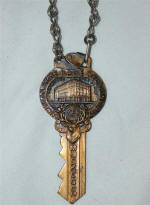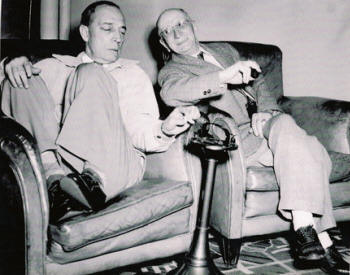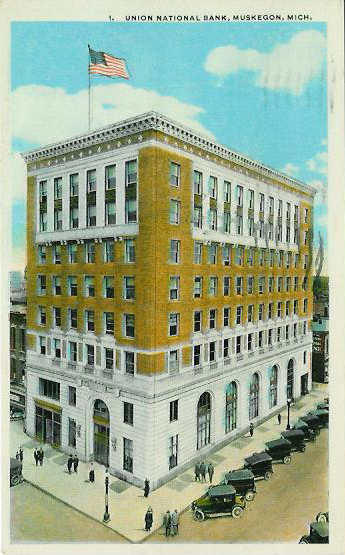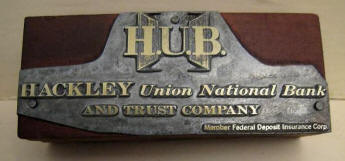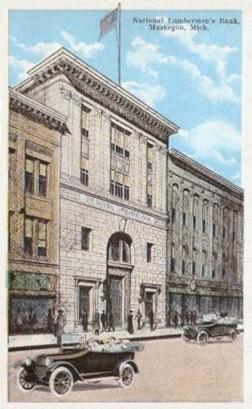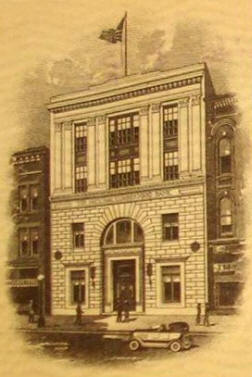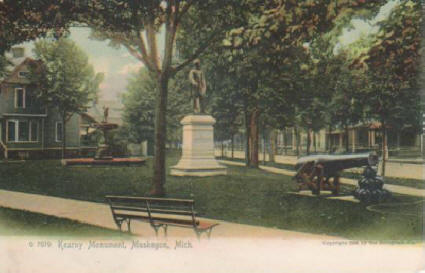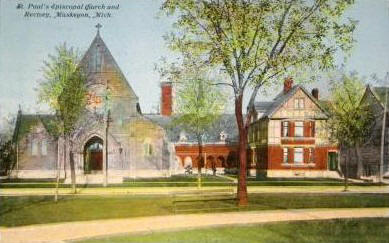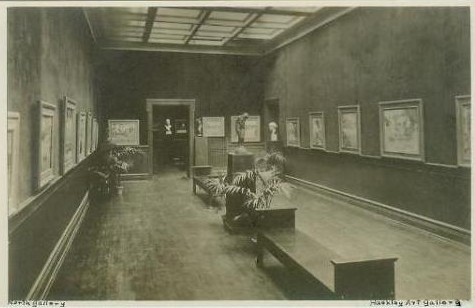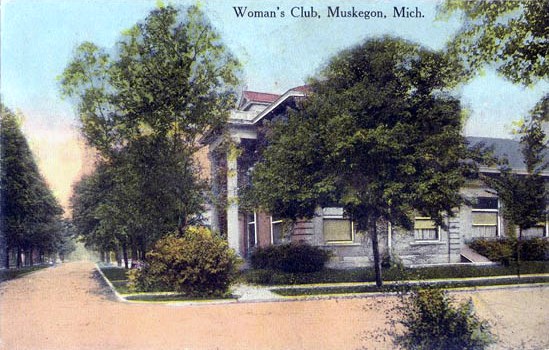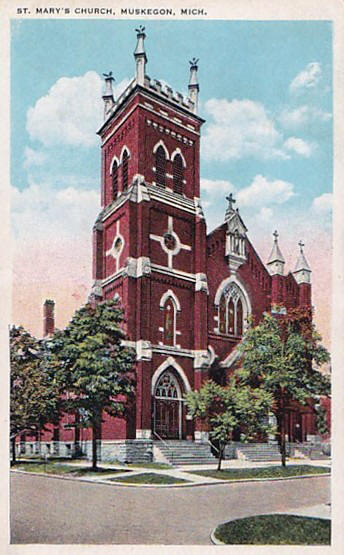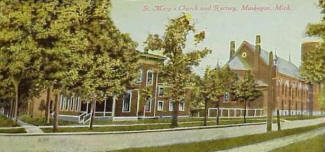Downtown Muskegon, MI
| A pre-1925's Visual History | ||||||||||||
| Click here to view more images of Muskegon | ||||||||||||
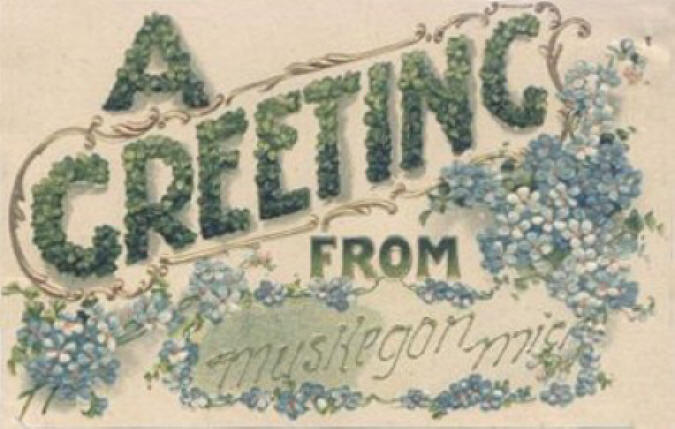 |
||||||||||||
|
||||||||||||
|---|---|---|---|---|---|---|---|---|---|---|---|---|
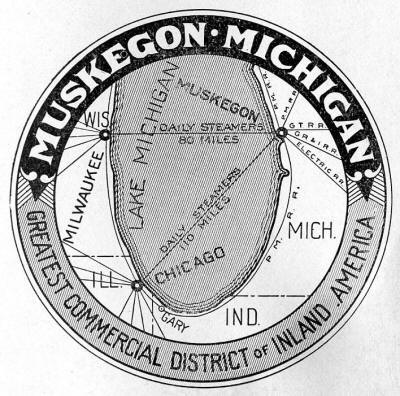 From a September 1911 publication of the Muskegon Chamber of Commerce designed "to introduce the outside world the industries of Muskegon". |
||||||||||||
 |
||||||||||||
| A Bird's Eye view of the downtown area. The large multistory building in the distance is the Amazon Knitting Mill. | ||||||||||||
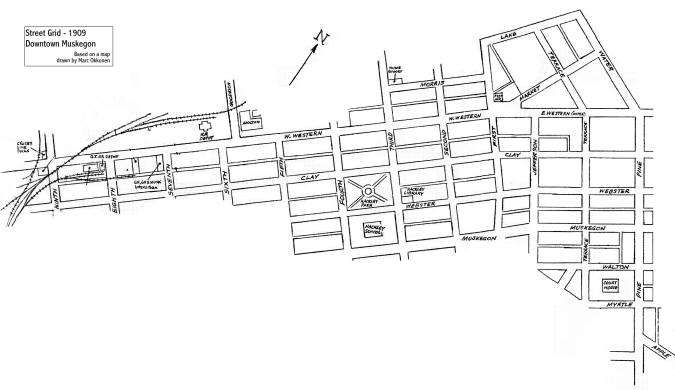 |
||||||||||||
|
WESTERN AVENUE from Eighth St. to Pine St. |
||||||||||||
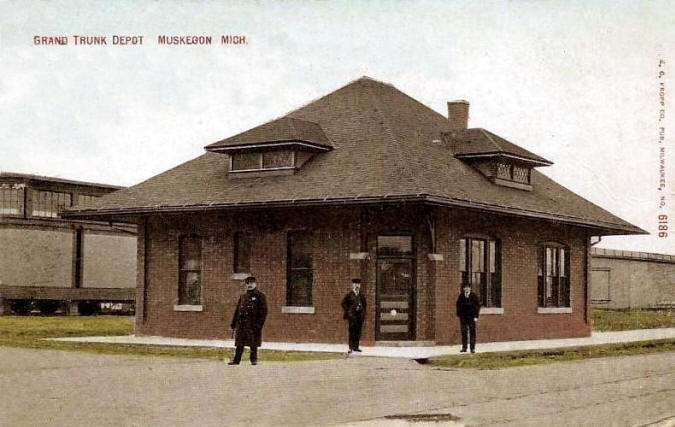 |
||||||||||||
|
Grand Trunk Depot - Western Ave. and Eighth St.
Fire broke out at the original depot and warehouse in late May 1908, likely caused by a lightening strike. In July, plans were announced for a new depot at the site, About the size of the original structure, vitrified brick (creating a shiny dark coating), was used to create the building to accommodate the ticket office and waiting room. In October, work began on removing the old structures that had served as both a passenger and freight depot for the previous 25 years. Over the next 50 days, the new structures were built, with the freight warehouse stretching 150 in length and 32 feet in width. Finishing touches to the new brick waiting room were wrapped up in late December. Agent Louis D. Knapp expected to move into the new quarters early in 1909 "from the improvised ticket office in an old coach" where he and his crew operated for the previous several months. |
||||||||||||
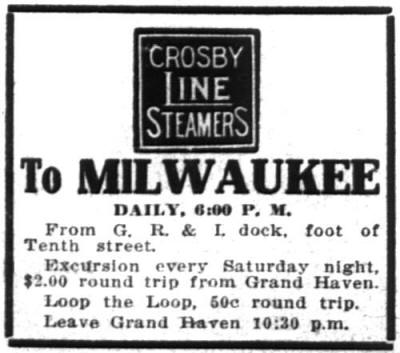 |
||||||||||||
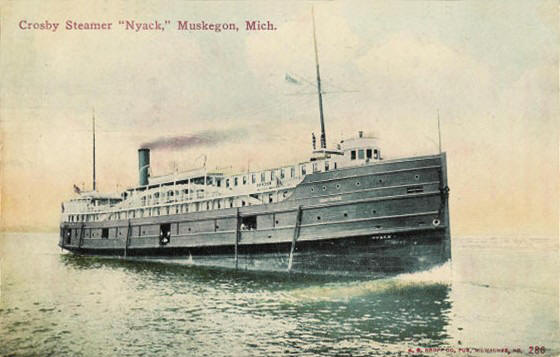 |
||||||||||||
| The Crosby Transportation Company offered cross-lake service between Muskegon and Milwaukee. | ||||||||||||
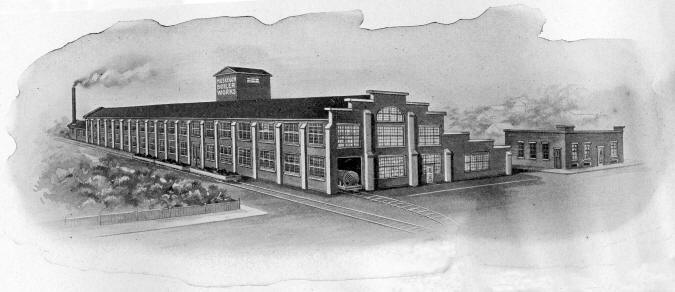 |
||||||||||||
| Muskegon Boiler Works building, located between Eighth and Ninth Streets and Clay Avenue, was built in 1905. | ||||||||||||
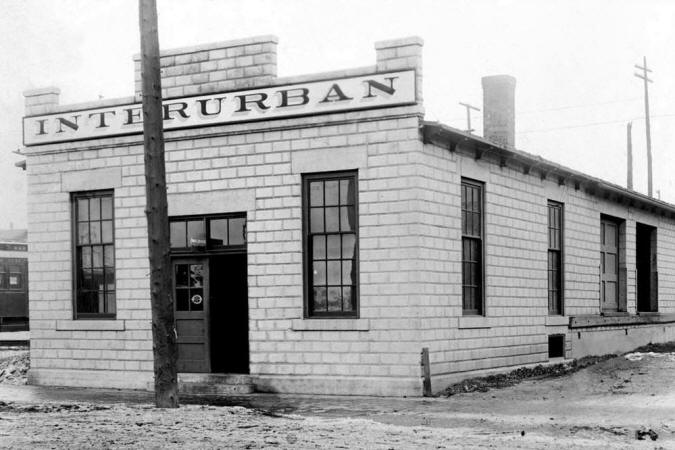 |
||||||||||||
| The Interurban barn at Eighth and Western. Also opened in late 1908, "the new Interurban depot...is not a pretty building as to architecture, but it is conveniently arranged to handle freight traffic. There is a pleasantly furnished waiting room, something which the old depot , planned only for handling the freight business, did not possess. After 47 years of service, the last of the Muskegon Traction and Lighting cars ceased operation at midnight, October 12, 1929. | ||||||||||||
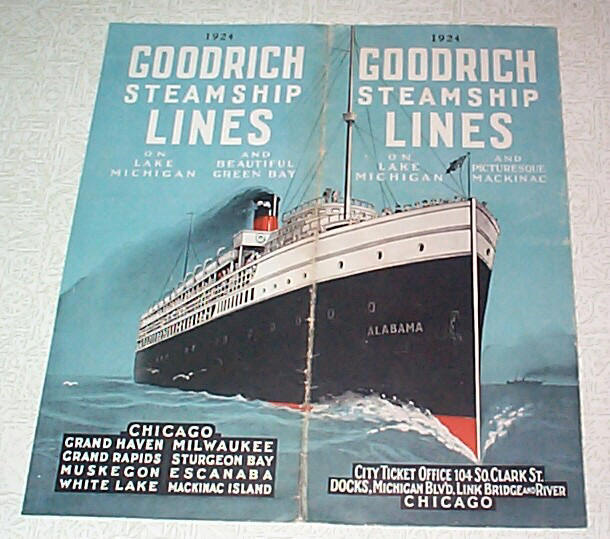 |
||||||||||||
| The Goodrich steamers, easily recognized by their red stacks, were based out of Chicago. They were one of multiple firms to serve the ports of West Michigan and beyond. | ||||||||||||
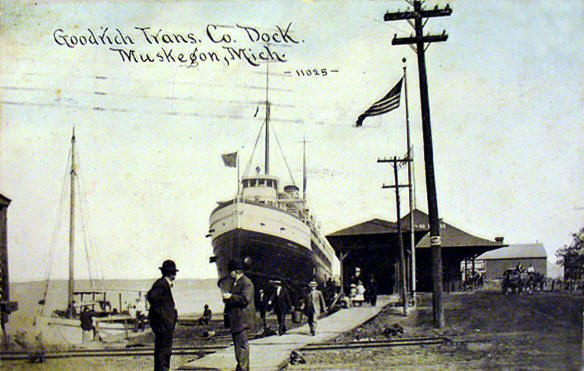 The Goodrich Transportation dock on Muskegon Lake. |
||||||||||||
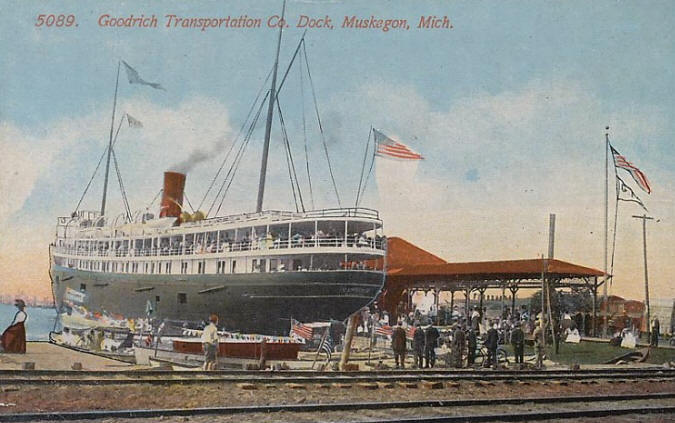 |
||||||||||||
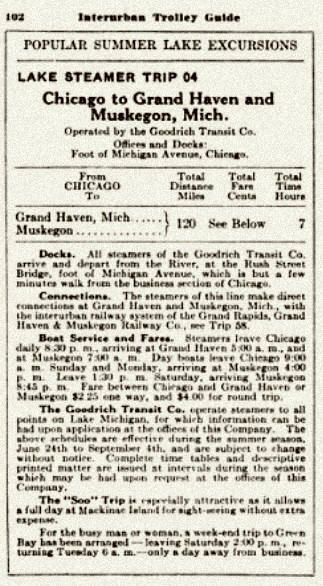 |
|
|||||||||||
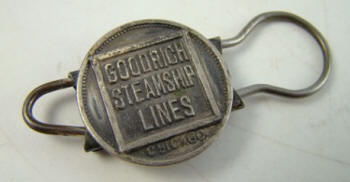 |
||||||||||||
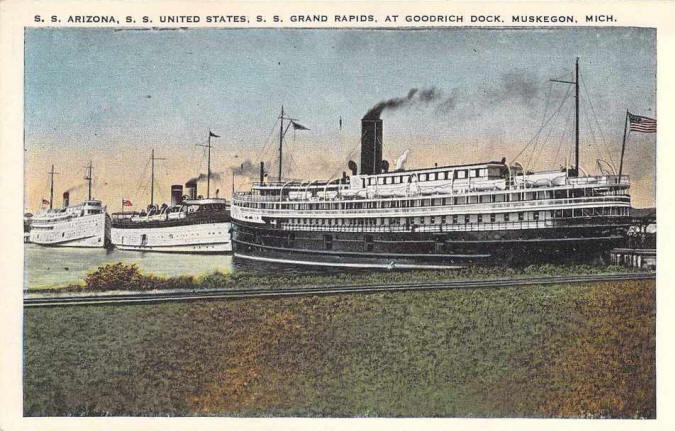 |
||||||||||||
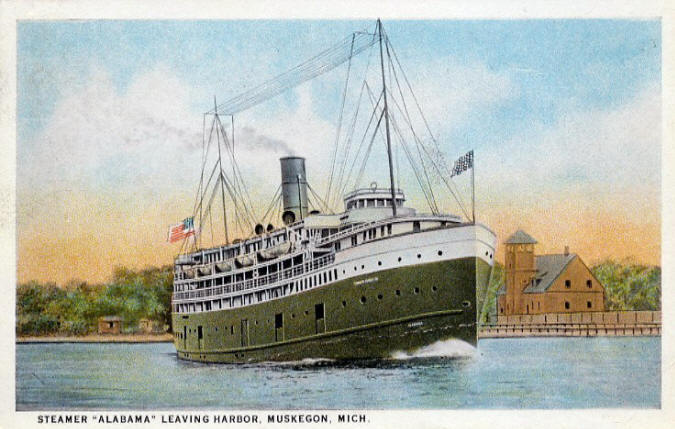 |
||||||||||||
|
Built in 1909, at Manitowoc, Wisconsin and launched
December 18,1909. The ALABAMA was a 272 foot passenger steamer run
by the Goodrich Line. Beginning in the spring of
1910, the steamer began service between Chicago, Grand Haven and
Muskegon and was a familiar site on Muskegon Lake until the demise of the
Goodrich Line in 1933. Retired from service in 1946, she was laid
up in Holland, MI, serving as a warehouse until 1960. Cut down to a
non-powered barge in 1961, she was scrapped in La Salle, Ontario, in
2006.
Click here for additional images and detail.
|
||||||||||||
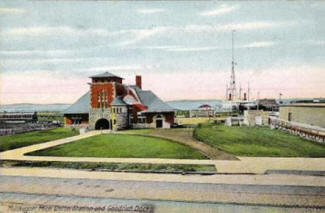 |
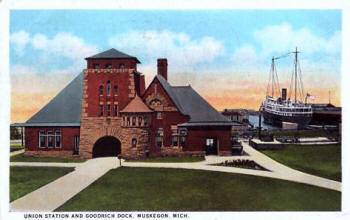 Union Station served the area as the prime railroad port of entry. |
|||||||||||
|

|
|||||||||||
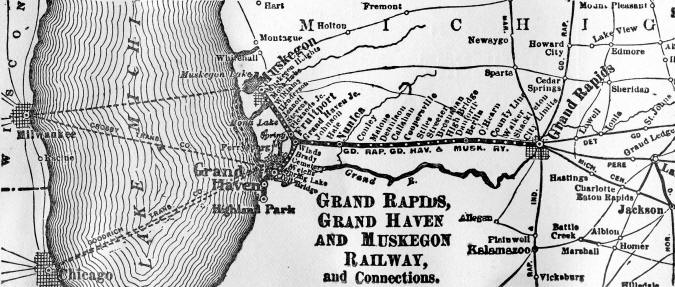 |
||||||||||||
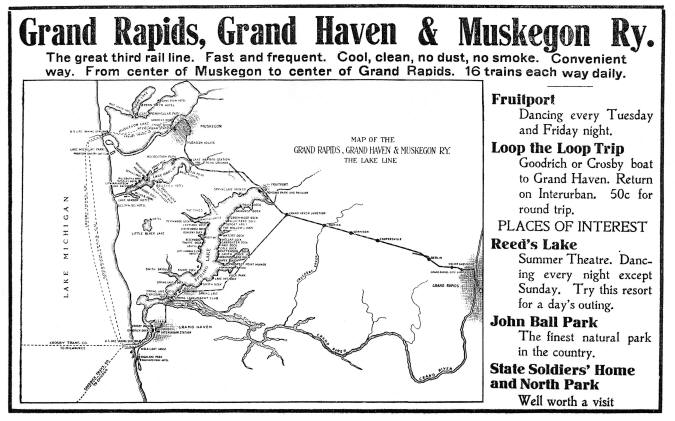 Click on the image for an enlarged view. |
||||||||||||
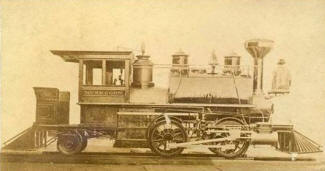 |
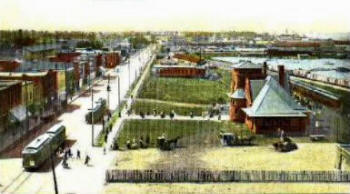 |
|||||||||||
| Looking Southwest from the Amazon Knitting Mill Co down Western Avenue. Muskegon Traction and Lighting offered trolley service to the city while the Grand Rapids, Grand Haven and Muskegon Railway Co offered interurban service allowing convenient travel around West Michigan. | ||||||||||||
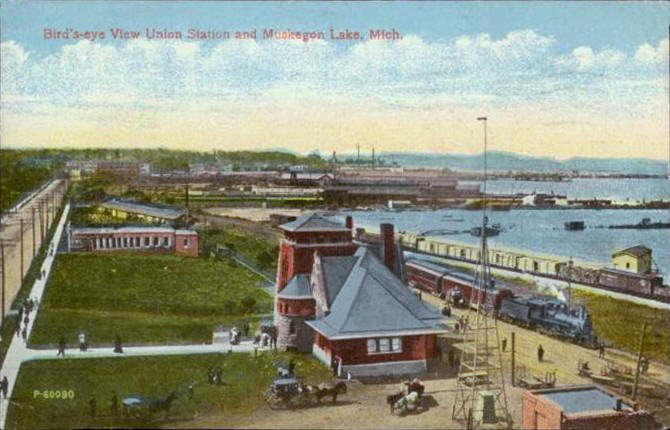 |
||||||||||||
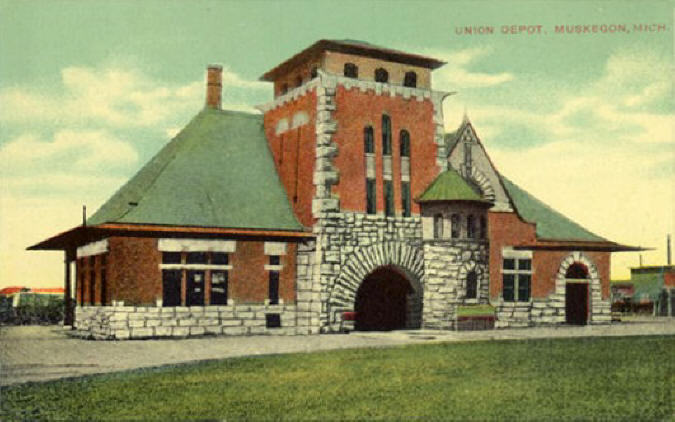 |
||||||||||||
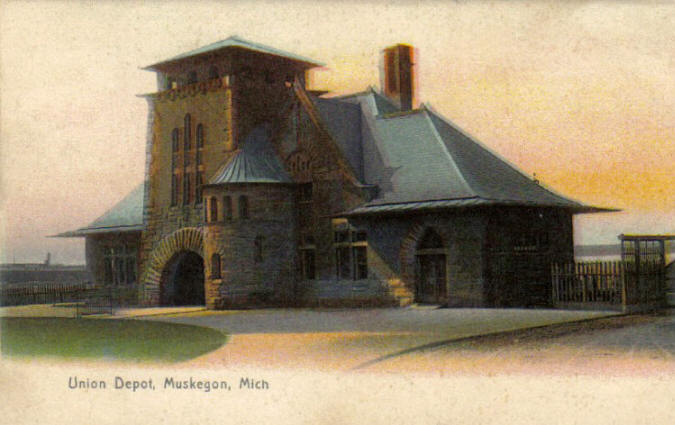 |
||||||||||||
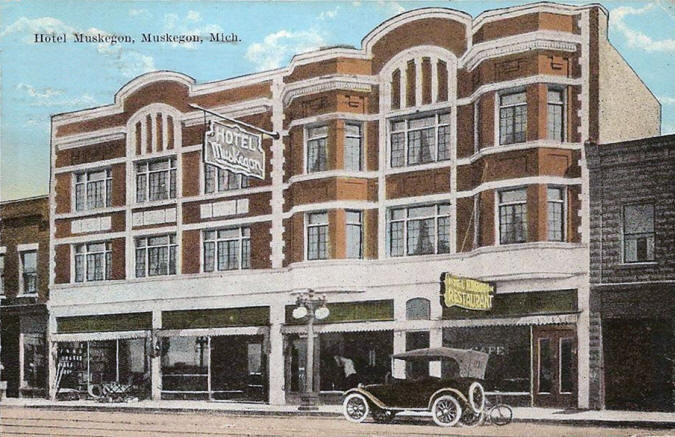 |
||||||||||||
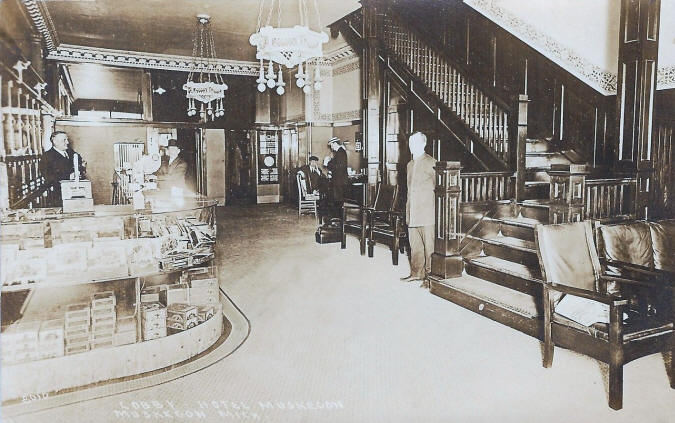 |
||||||||||||
| The Hotel Muskegon, and a postcard of its lobby from around 1916. The building was located across the street from Union Station. | ||||||||||||
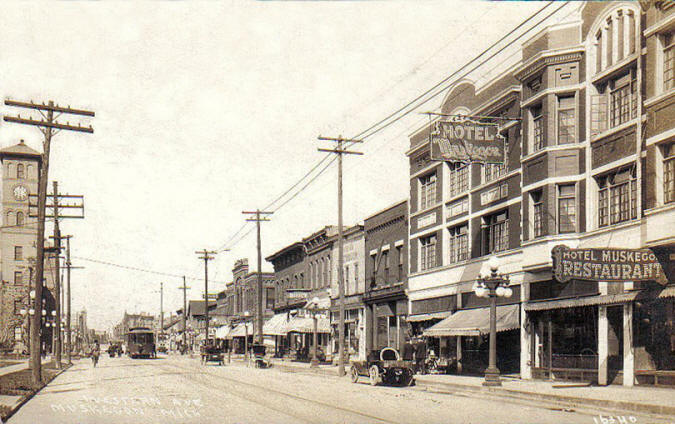 |
||||||||||||
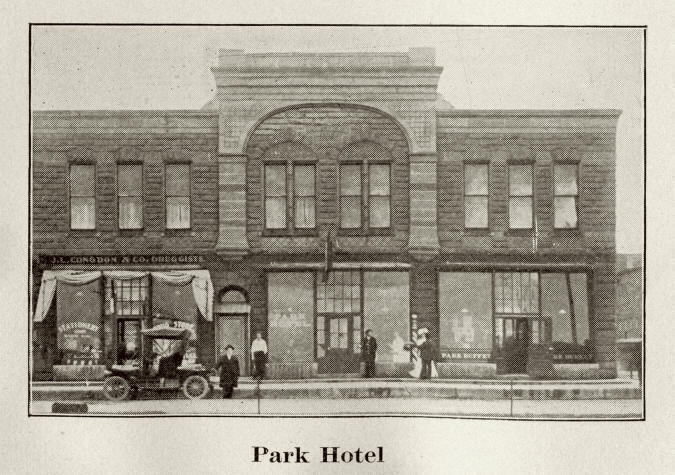 |
||||||||||||
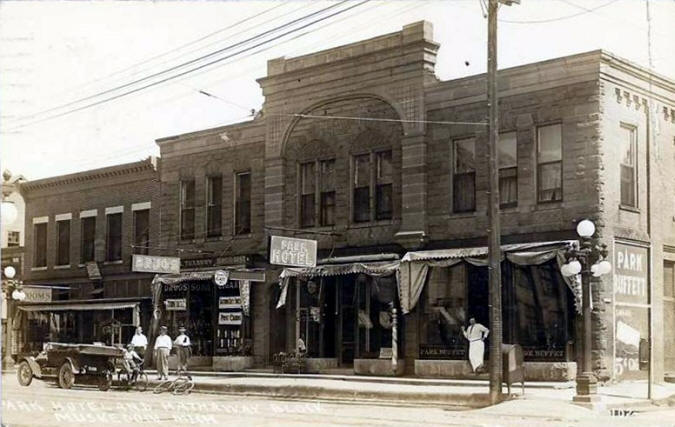 |
||||||||||||
| The Park Hotel, later known as the Hotel Campau and later, the Lake View Hotel. It is located at the corner of Sixth and Western, across from the Amazon Knitting Co. The structure is known as the McCracken Building. | ||||||||||||
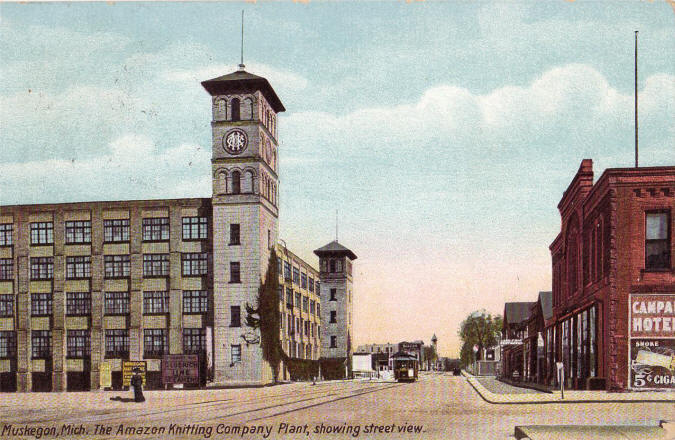 |
||||||||||||
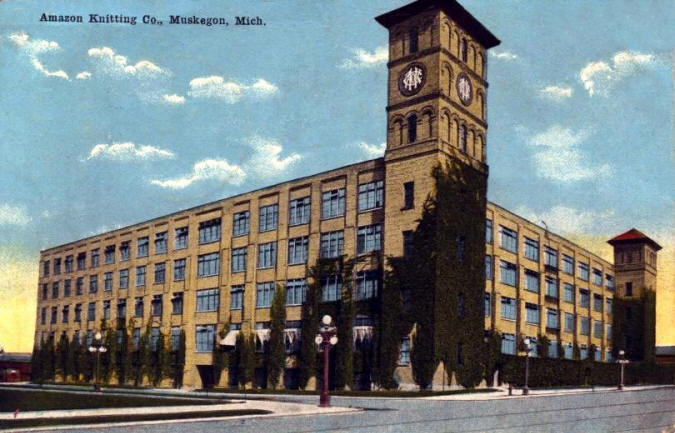 |
||||||||||||
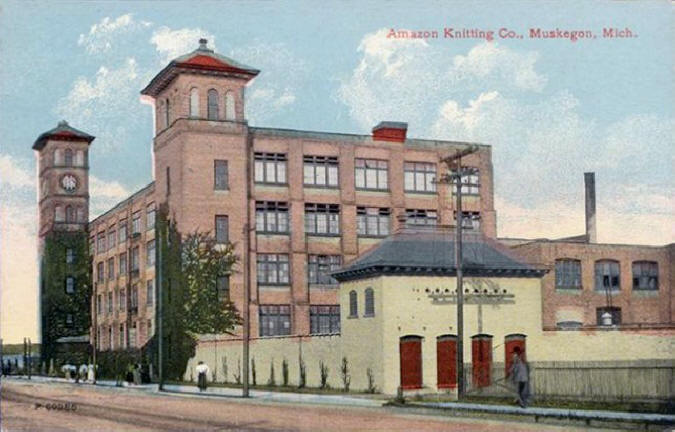 |
||||||||||||
| The Amazon Knitting Company, located between Fifth Street and Sixth Street on Western Avenue. | ||||||||||||
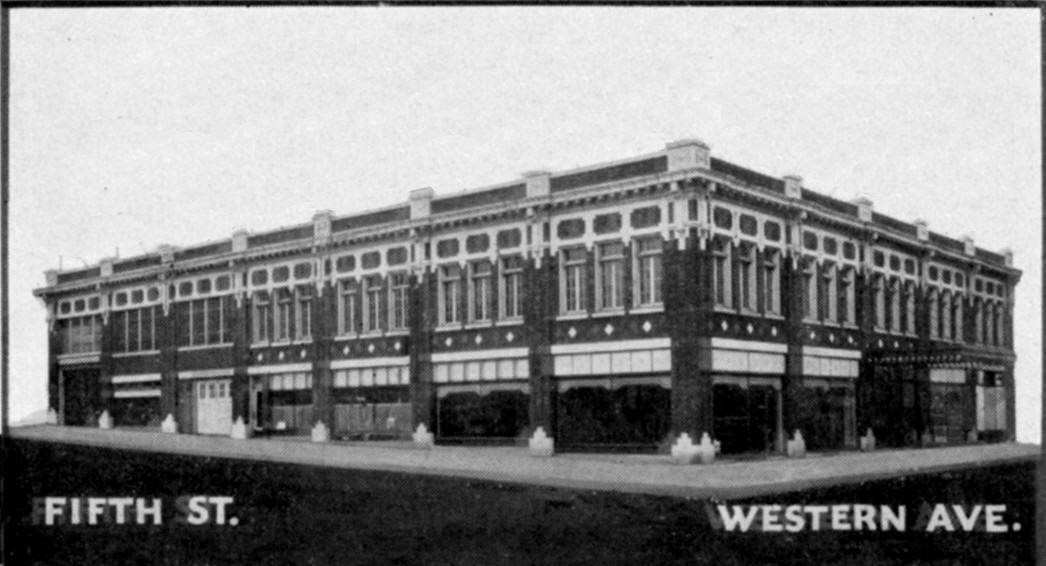 |
||||||||||||
| An August 1920 Muskegon Chronicle reported Frank E. Hathaway Inc. was "engaged in the construction of its immense new garage building" at 201-203 Western Avenue and Fifth Street. It was described as one of the largest and best equipped in the state. | ||||||||||||
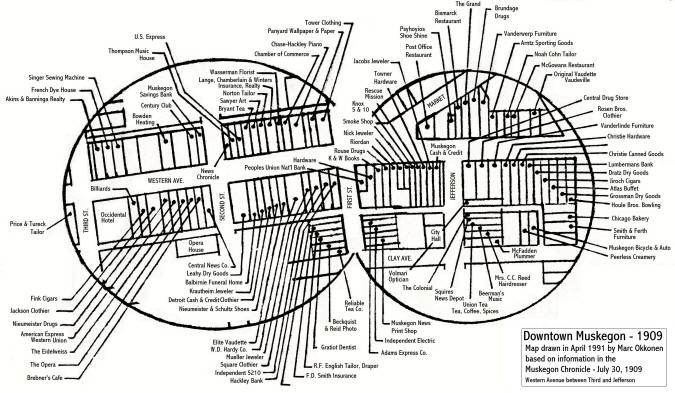 |
||||||||||||
| Western Avenue between Third Street and Jefferson. This segment of the map, drawn by historian Marc Okkonen in April 1991 is based on information found in the Muskegon Chronicle - July 30, 1909. Click on the image for an enlarged view. | ||||||||||||
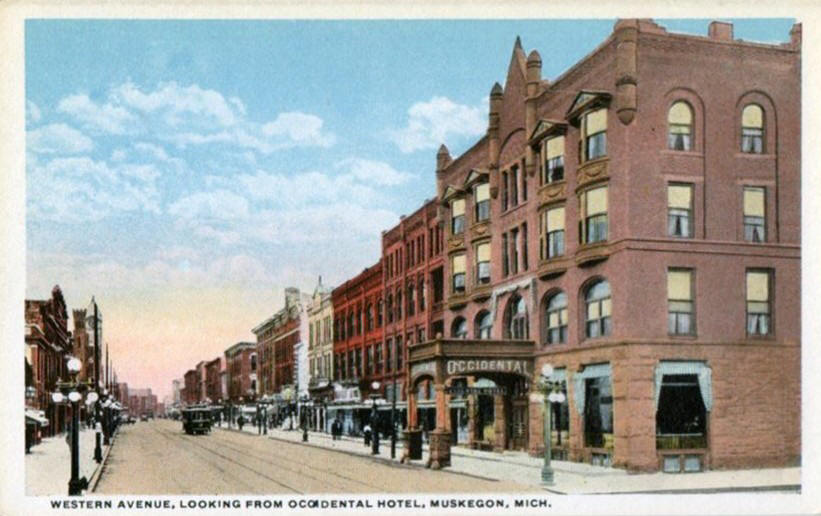 |
||||||||||||
| The Occidental Hotel, cira 1915, located at the corner of Third Street and Western Avenue. The facility would undergo numerous additions and alterations over the years, before its final dramatic demise in April 1975 | ||||||||||||
|
||||||||||||
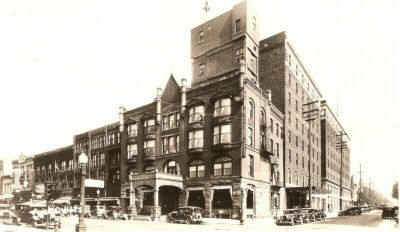 A later view of the Occidental. The older section facing Western Avenue was destroyed in a spectacular fire in March 1936. |
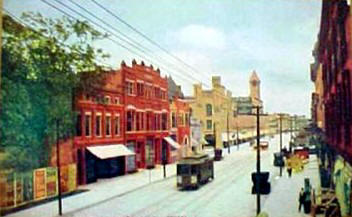 Western Avenue looking northeast from Third Street. |
|||||||||||
|
|
||||||||||||
| Western Avenue looking East. Notice the Garden Theater, located to the right in the image. | ||||||||||||
|
||||||||||||
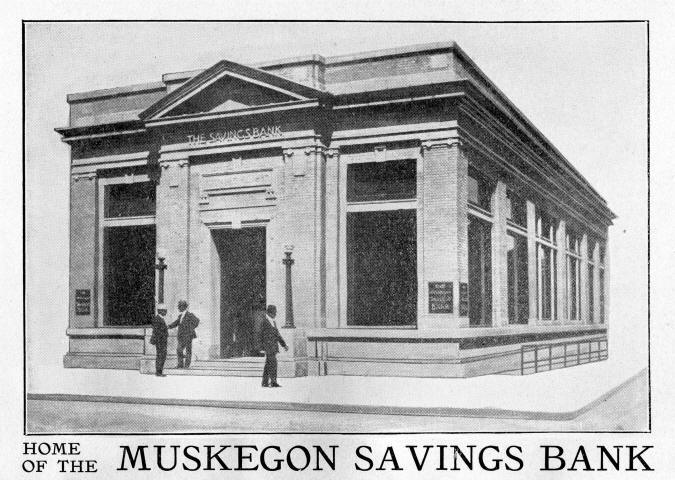 |
||||||||||||
| Located on the northwest corner of Western Avenue and Second Street, next to the Century Club, the Muskegon Saving Bank survived the 1970's urban renewal project that swept the downtown area. | ||||||||||||
|
||||||||||||
|
|
||||||||||||
| In 1911, the Elks Lodge purchased the old Grand Opera House for $25,000, and in July began remodeling the building. The upper floors were used by the Elks, while street level was reserved for use by merchants. | ||||||||||||
|
|
||||||||||||
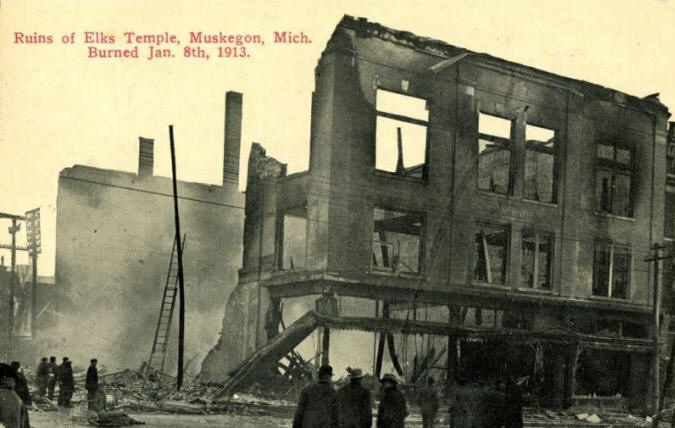 |
||||||||||||
| "Reputed to be the finest in Michigan," on January 8, 1913, less than nine months after the dedication, fire swept through the Elks Temple. The combination of a light breeze, a double firewall on the west side of the building, and, after the wells at the pumping station went dry, water pumped into the city's water mains by the Amazon Knitting Mill and the Stewart Hartshorn Company, firefighters were able to contain the blaze, and save the rest of downtown Muskegon. | ||||||||||||
|
||||||||||||
|
|
||||||||||||
| Muskegon's Elks Temple, once located at the southeast corner of Western Avenue and Second Street, across from the Muskegon Savings Bank, opened in April 1914. Click here for a history of the Lodge, | ||||||||||||
|
||||||||||||
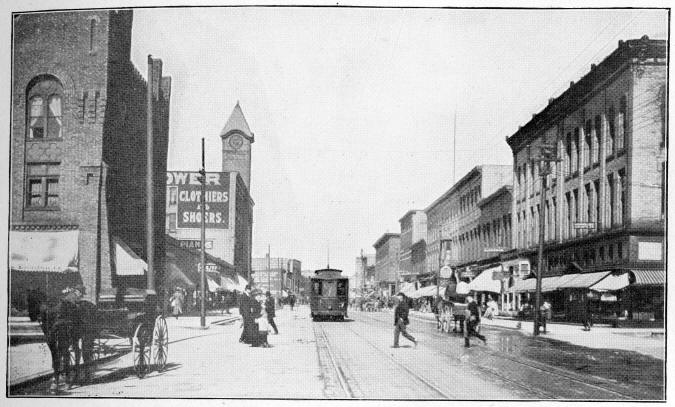 Looking East from Second Street. Note the side of the Masonic Temple on left. |
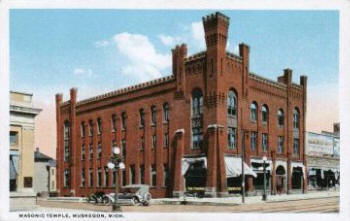 The Masonic Temple, located at the northeast corner of Second Street and Western Avenue. The Muskegon lodge was chartered on January 1, 1863. |
|||||||||||
|
|
||||||||||||
| Bird's Eye view of Western Avenue and the Harbor. In the distance you can see the WWI Victory Arch that once spanned the roadway. | ||||||||||||
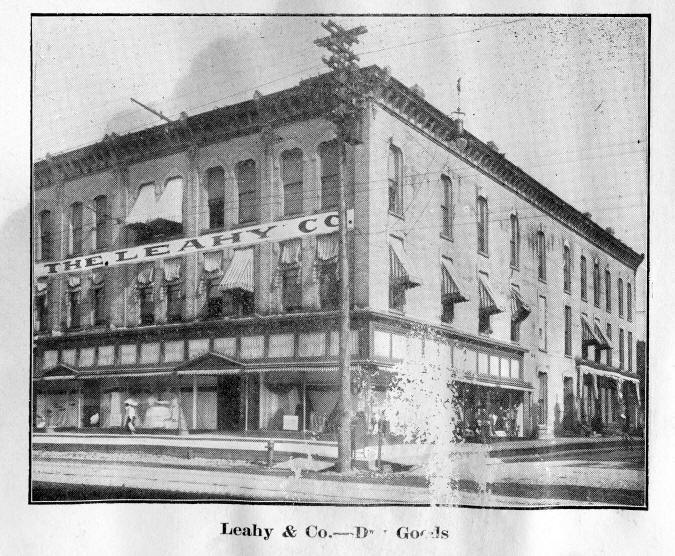 |
||||||||||||
| The building that hosted Leahy Dry Goods on Western Avenue was consumed by fire on February 22, 1946. Two-thirds of the storefronts located between First and Second Streets were lost in the spectacular blaze that started down the block in the basement of the Wm. D. Hardy & Co. department store. | ||||||||||||
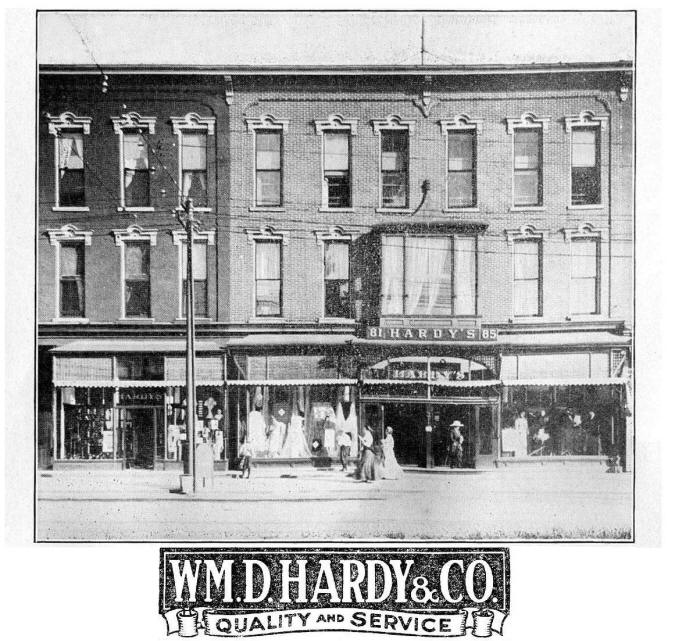 |
||||||||||||
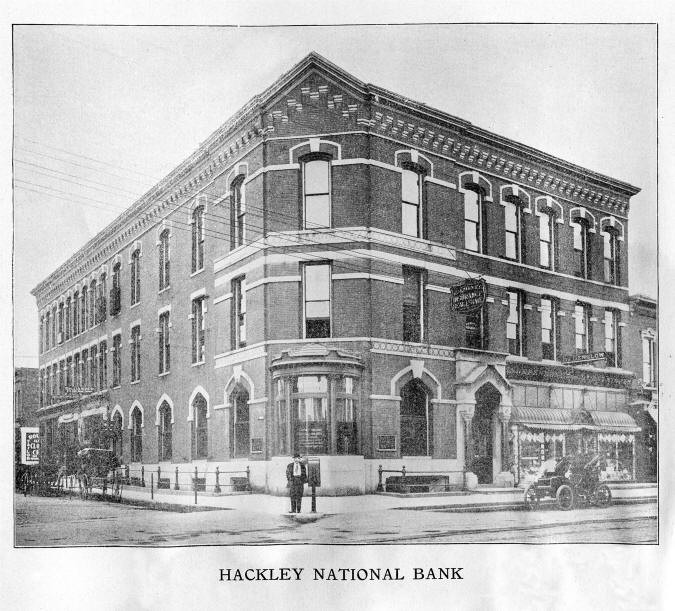 |
||||||||||||
| Hackley National Bank, located on the southwest corner of Western Avenue and First Street. | ||||||||||||
|
||||||||||||
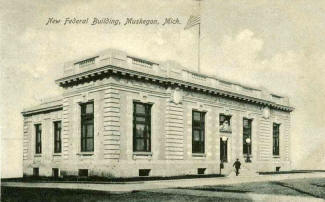 |
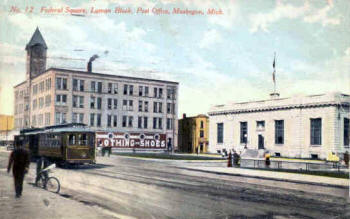 |
|||||||||||
| Muskegon' Federal Building, designed by federal architect James Know Taylor, rose from the landscape in 1904. It was replaced a short 33 years later by a new Post Office building that is still in use. | The Lyman Block, built in 1888 by Lyman G. Mason (1829-1898). At the time, the Lyman Block was Muskegon's only four story building, and featured a passenger elevator, and fire-proof vaults. Heated by steam, it was lighted by both gas and electricity. | |||||||||||
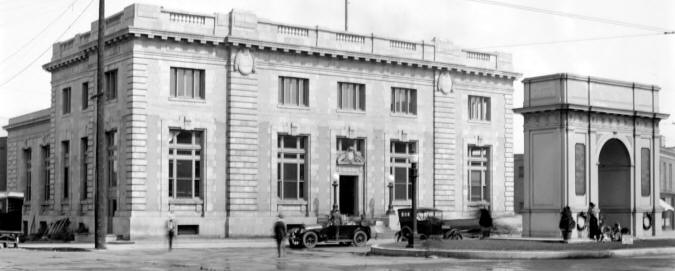 |
||||||||||||
|
The corner of Western Avenue and Market Street looking east. |
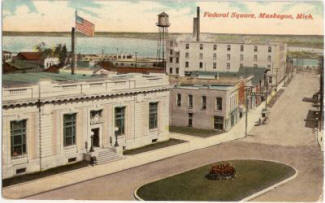 Federal Square, situated in front of the post office at the base of Market Street. |
|||||||||||
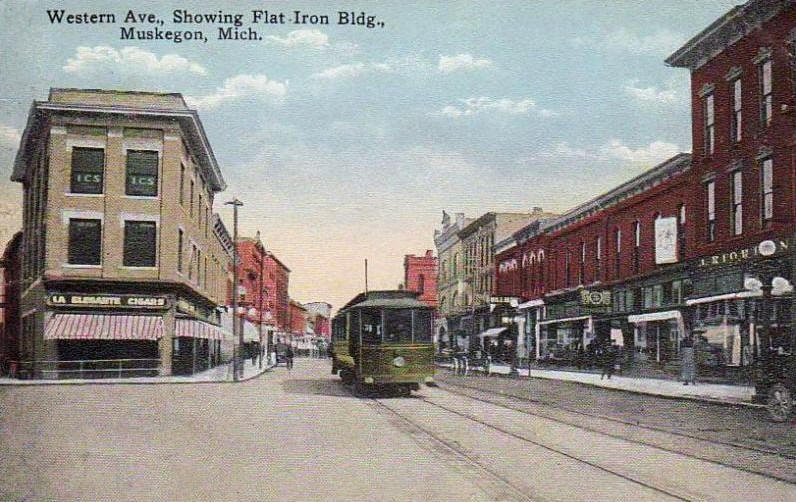 |
||||||||||||
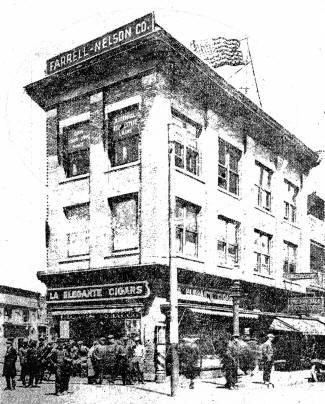 |
Looking east on Western Avenue from the
Flatiron Building. Notice
to the far left the building occupied by
 the
J. Riordan Co. the
J. Riordan Co. |
|||||||||||
| Western Avenue side of the Flat Iron Building at Market Street | ||||||||||||
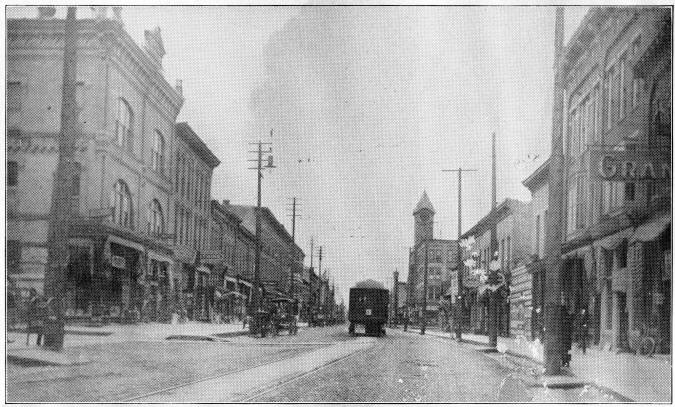 Looking west down Western Avenue from Jefferson Street. |
||||||||||||
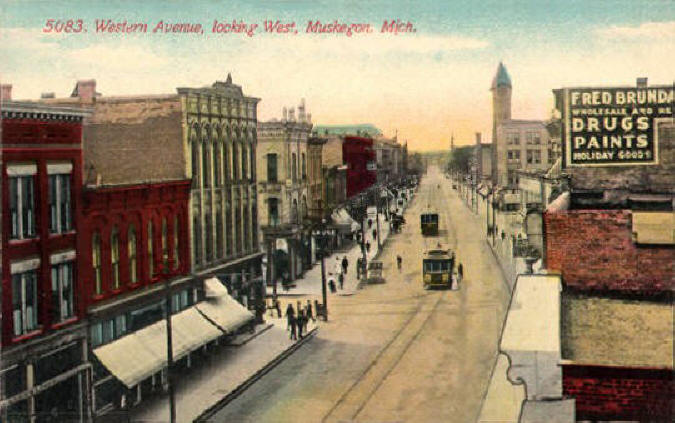 |
||||||||||||
| Looking west down Western Avenue from Terrace Street around 1912. | ||||||||||||
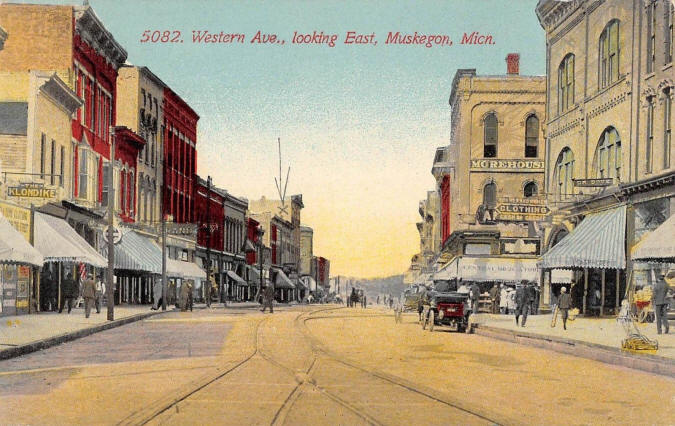 |
||||||||||||
|
CONTINENTAL MOTORS Powerful as the Nation |
||||||||||||
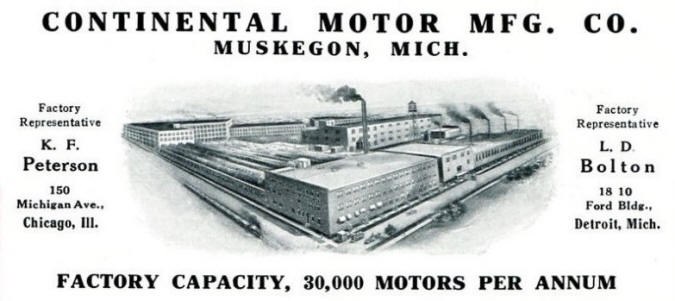 |
||||||||||||
|
|
||||||||||||
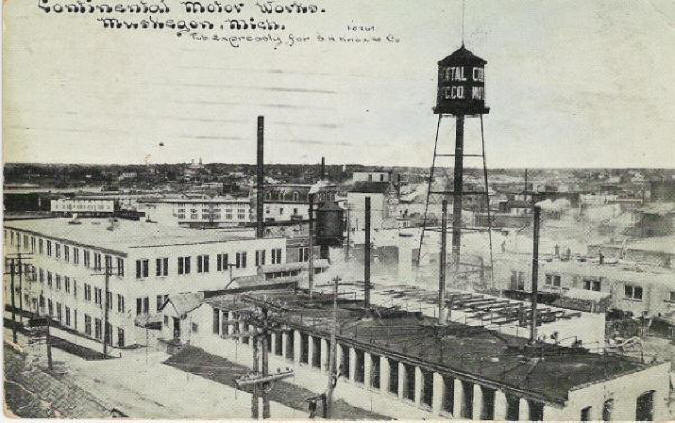 |
||||||||||||
|
This shot from around 1912 shows Continental Motor Works, located at the
base of Western Avenue along the waterfront. A manufacturer of automobile engines for numerous car makers in the early days, including Dodge, Reo, Auburn and Checker Cab. In 1933, the company would introduce a line of passenger cars. The move would nearly bankrupt the company. |
||||||||||||
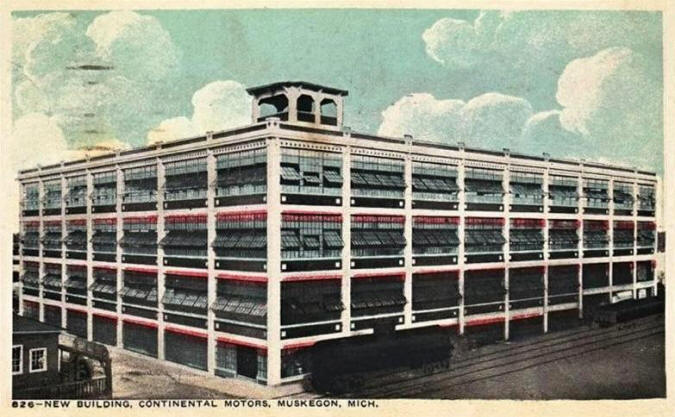 |
||||||||||||
| The new facility opened on the property in 1921. The land has that once hosted the company was cleared in the 1990s and is in the process of being redeveloped. | ||||||||||||
|
|
||||||||||||
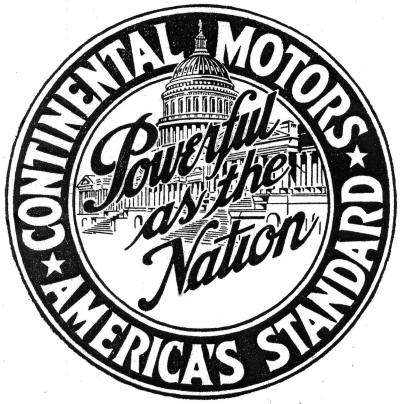 |
||||||||||||
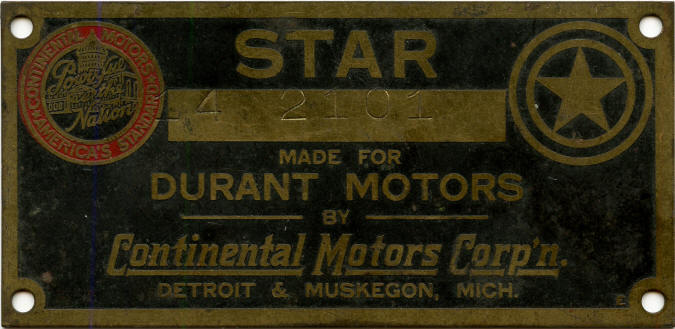 |
||||||||||||
|
CLAY to WEBSTER from Sixth St. to First St. |
||||||||||||
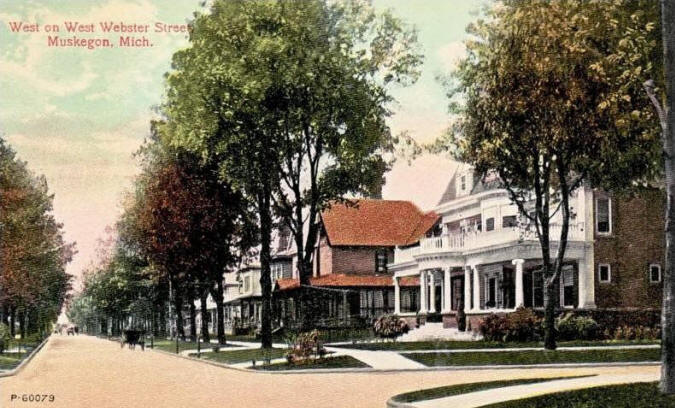 |
||||||||||||
| Northwest corner of Fifth Street and Webster Avenue. | ||||||||||||
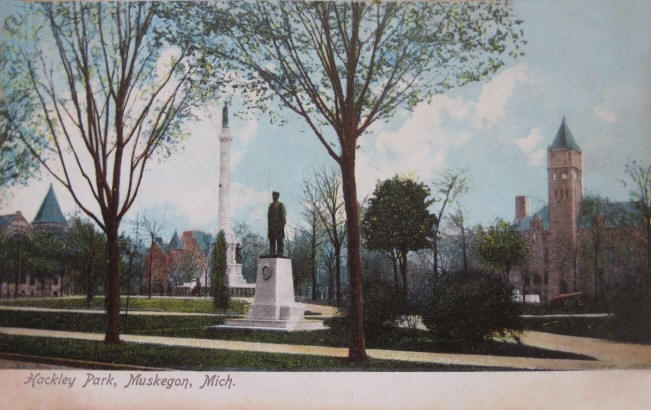 Hackley Park from the corner of Fourth Street and Clay Avenue. Joseph Carabelli created the 76-foot tall Civil War monument at the center of the property. It was dedicated on Memorial Day, May 30, 1892. Hackley also commissioned sculptor Charles Niehaus to create monuments to Abraham Lincoln and David Farragut, and sculptor J. Massey Rhind to create pieces honoring Ulysses S. Grant and William Tecumseh Sherman. The four statues were dedicated on Memorial Day, 1900. |
||||||||||||
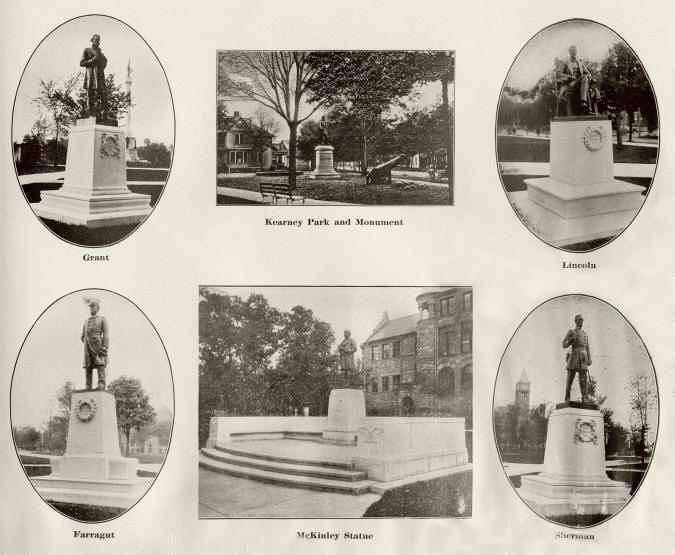 |
||||||||||||
|
||||||||||||
|
|
||||||||||||
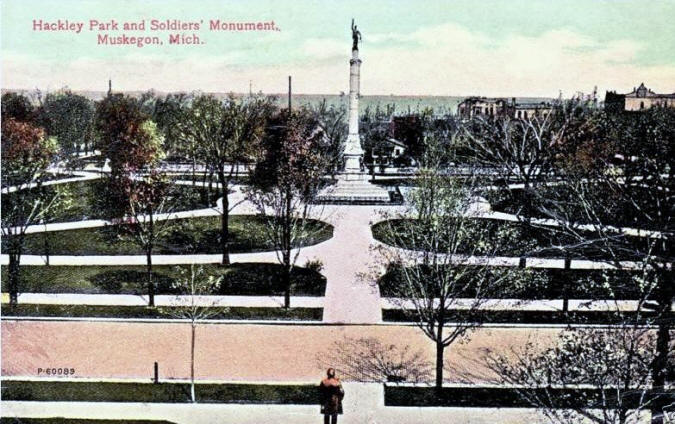 |
||||||||||||
| Muskegon's Hackley Park, looking north toward Muskegon. This postcard show the downtown area before the expansion of the Occidental Hotel. | ||||||||||||
|
|
||||||||||||
| A later shot of Hackley Park from a similar vantage point. This was taken after 1920 expansion of the Occidental Hotel. | ||||||||||||
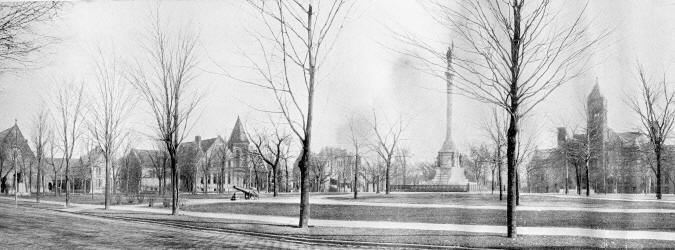 A street level view of Hackley Park looking toward Third Street. |
||||||||||||
|
||||||||||||
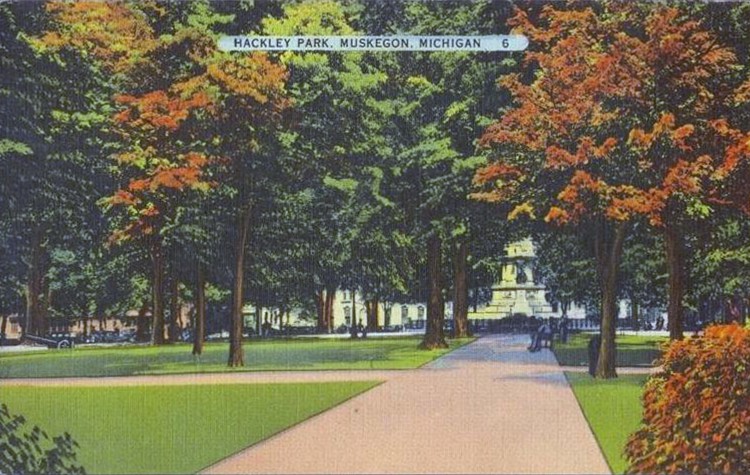 |
||||||||||||
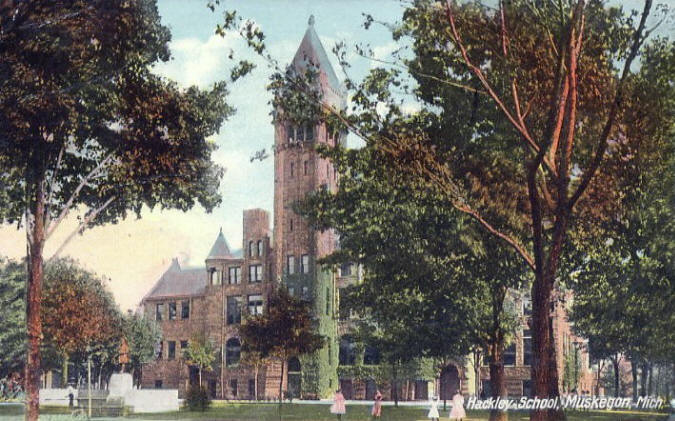 |
||||||||||||
| An image of the Hackley School, located between Webster and Muskegon Avenues and Third and Fourth Streets. Note the statue to William McKinley in the image. | ||||||||||||
|
|
||||||||||||
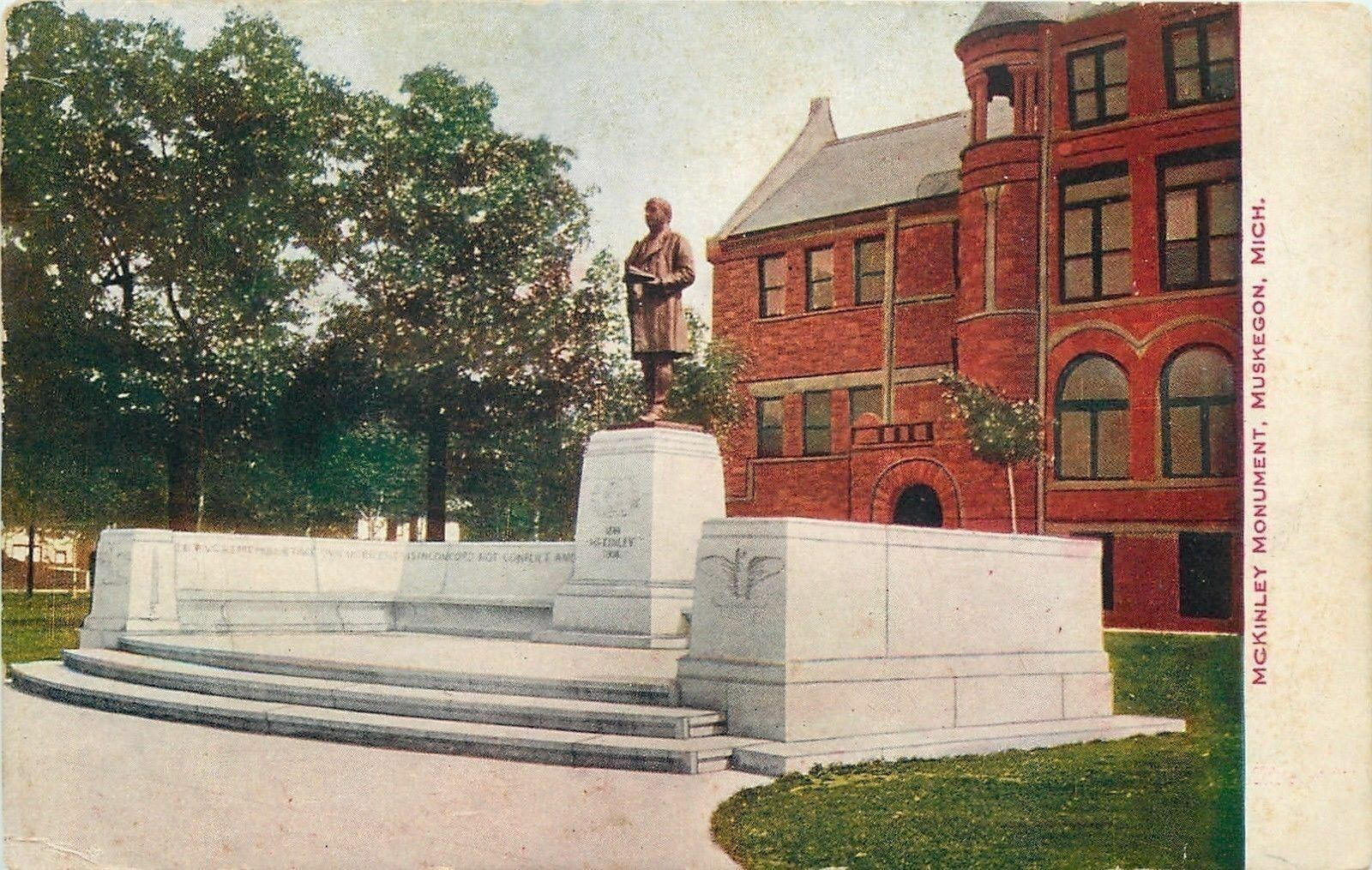 |
||||||||||||
| Another donation from Hackley was Charles H. Niehaus' sculpture of President William McKinley, the first placed in the United States, a mere six weeks following his assassination. According to an article in National Magazine, written by Muskegon's own Douglas Malloch, the memorial was unveiled in the presence of fifty thousand people on Memorial Day, 1902. | ||||||||||||
|
|
||||||||||||
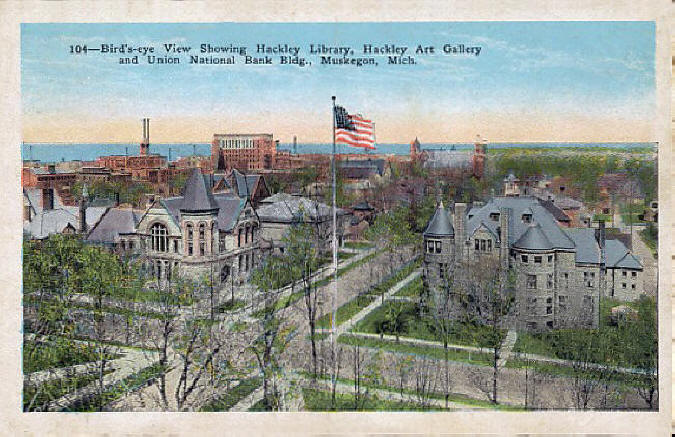 |
||||||||||||
| Hackley Public Library, dedicated in 1888 on the northeast corner of Third Street and Webster, was a gift to the city from its greatest benefactor, Charles H. Hackley. The Torrent House (left), built in 1892 was the 31-room mansion of lumber baron John Draper Torrent (1833-1915). | ||||||||||||
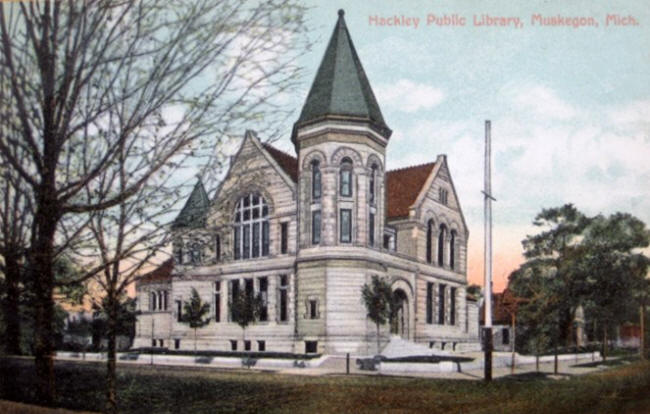 |
||||||||||||
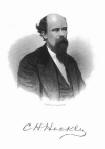 Dedicated
on October 15, 1890, Hackley Public Library was Charles Hackley's first
gift to the city that had allowed him to amass a fortune during Muskegon's
lumbering days. His donation of $125,000 to the Muskegon Public
School Board of Education
for "a suitable and commodious building for a public library and reading
room" led to the construction of this ornate building. The cornerstone
was set in place on May 25, 1889 at the corner of Third Street and
Webster Avenue. In 1902, a two-story addition, which featured a glass
floor, was constructed for additional storage of books. Dedicated
on October 15, 1890, Hackley Public Library was Charles Hackley's first
gift to the city that had allowed him to amass a fortune during Muskegon's
lumbering days. His donation of $125,000 to the Muskegon Public
School Board of Education
for "a suitable and commodious building for a public library and reading
room" led to the construction of this ornate building. The cornerstone
was set in place on May 25, 1889 at the corner of Third Street and
Webster Avenue. In 1902, a two-story addition, which featured a glass
floor, was constructed for additional storage of books.The upper floor of the original building was to become an art gallery, thanks to another donation by Hackley to be used for the purchase of "pictures of the best kind." That gift instead would evolve into a new facility - the Hackley Art Gallery. |
||||||||||||
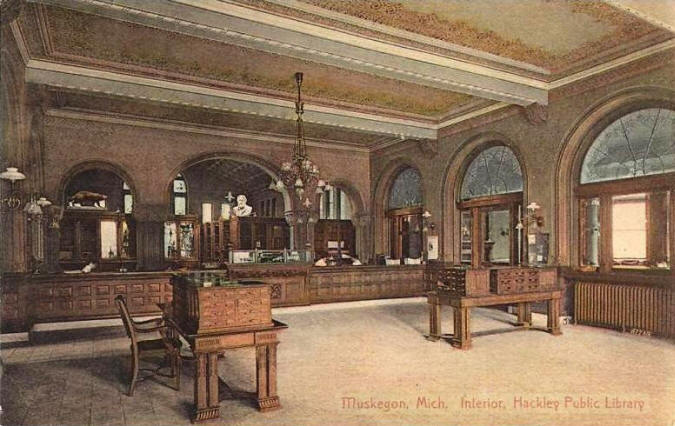 |
||||||||||||
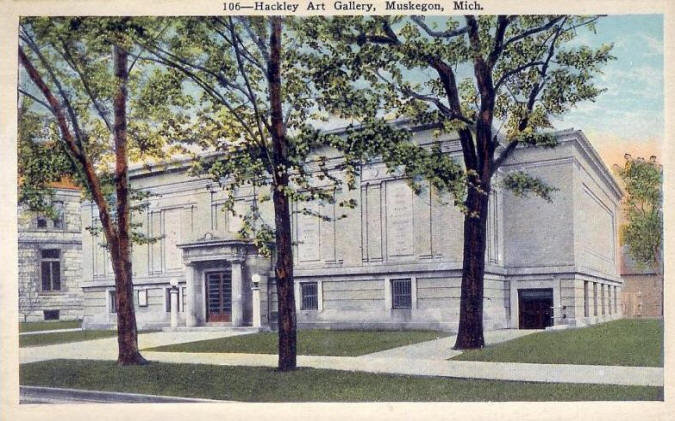 |
||||||||||||
| Another gift to the city from lumber baron Charles Hackley, the Hackley Art Gallery was built around a $150,000 donation. After purchasing property located next to Hackley Library, Muskegon Public Schools constructed a museum to house their growing collection of art. The dedication on June 21, 1912 received press in New York, Boston, Chicago and London. The museum was initially guided by director Raymond Wyer, and his wise acquisitions helped build the stellar reputation held by the museum in art circles. Lulu Miller followed Wyer as director. She was recognized as only the second female in the nation to head an art museum. | ||||||||||||
|
||||||||||||
|
|
||||||||||||
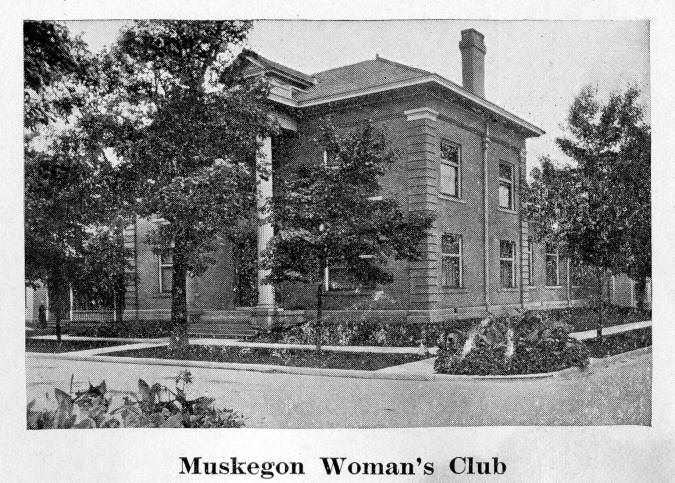 |
||||||||||||
|
||||||||||||
|
||||||||||||
|
|
||||||||||||
| First Baptist Church at the corner of Second and Clay. | ||||||||||||
|
MORRIS from Third St. to First St. |
||||||||||||
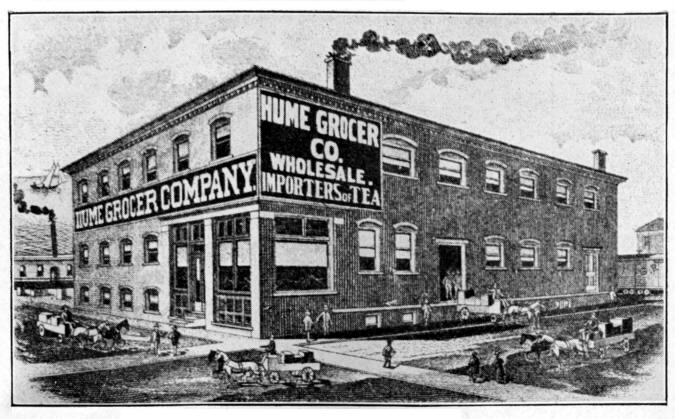 |
||||||||||||
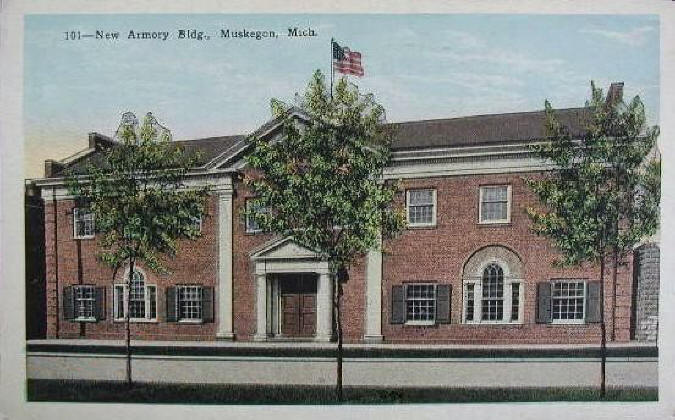 |
||||||||||||
| The Armory Building - built in 1919. | ||||||||||||
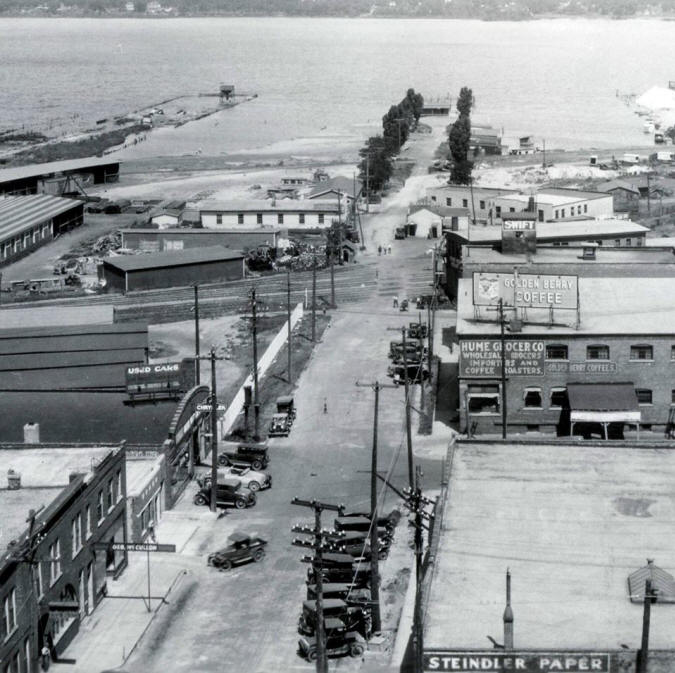 |
||||||||||||
| Third Street from Western Avenue toward Muskegon Lake. | ||||||||||||
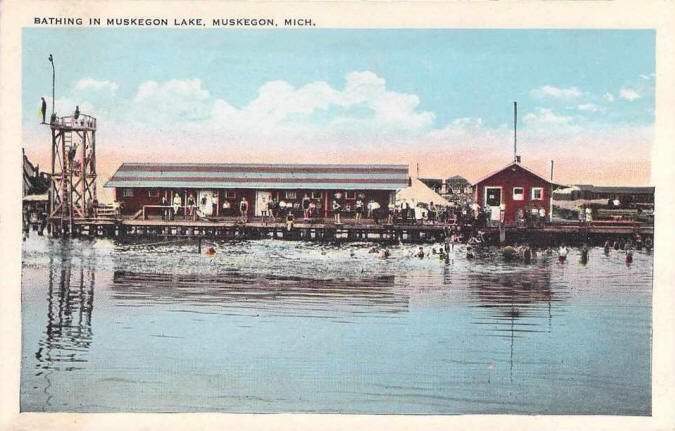 |
||||||||||||
| Third Street Bathing Beach - opened July 4,1924. | ||||||||||||
